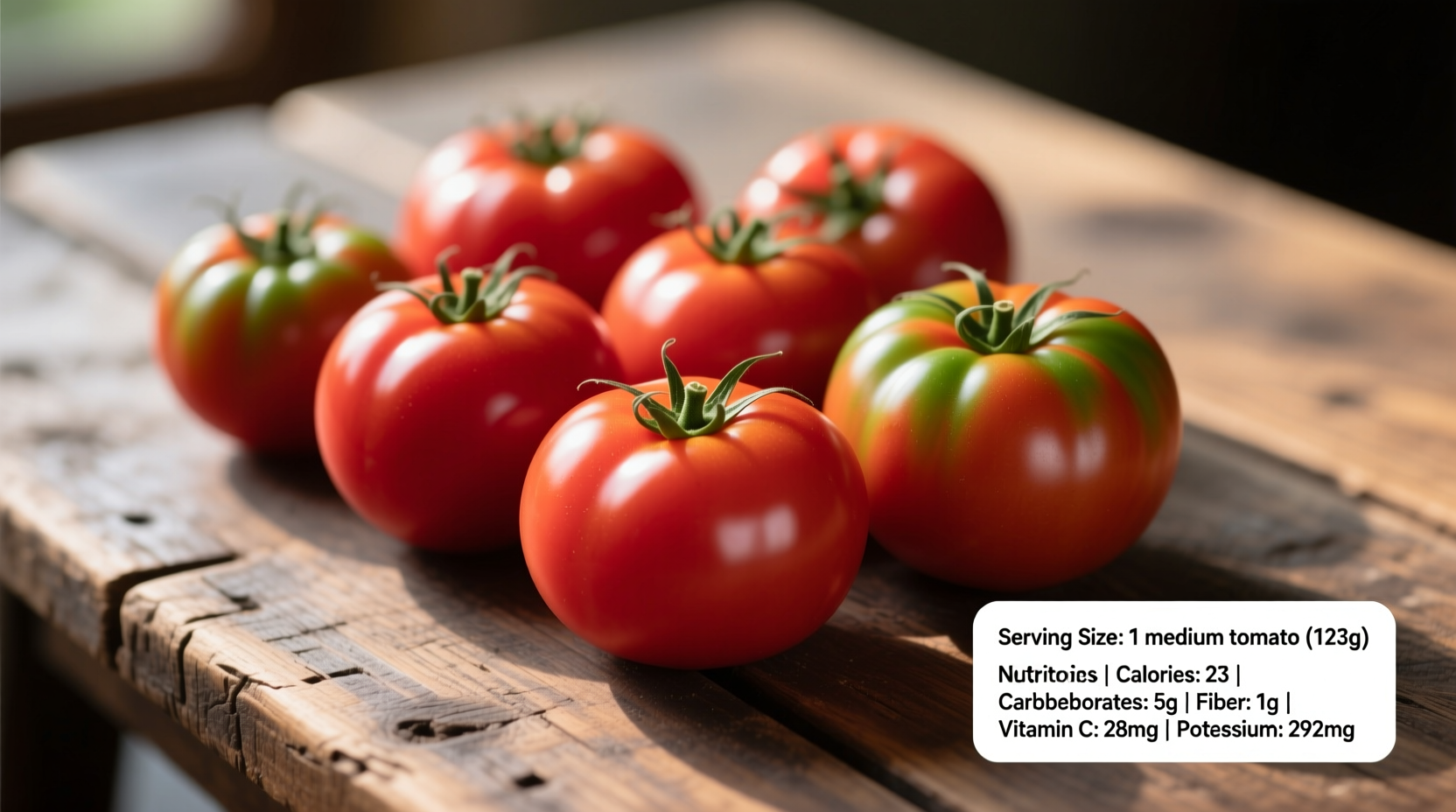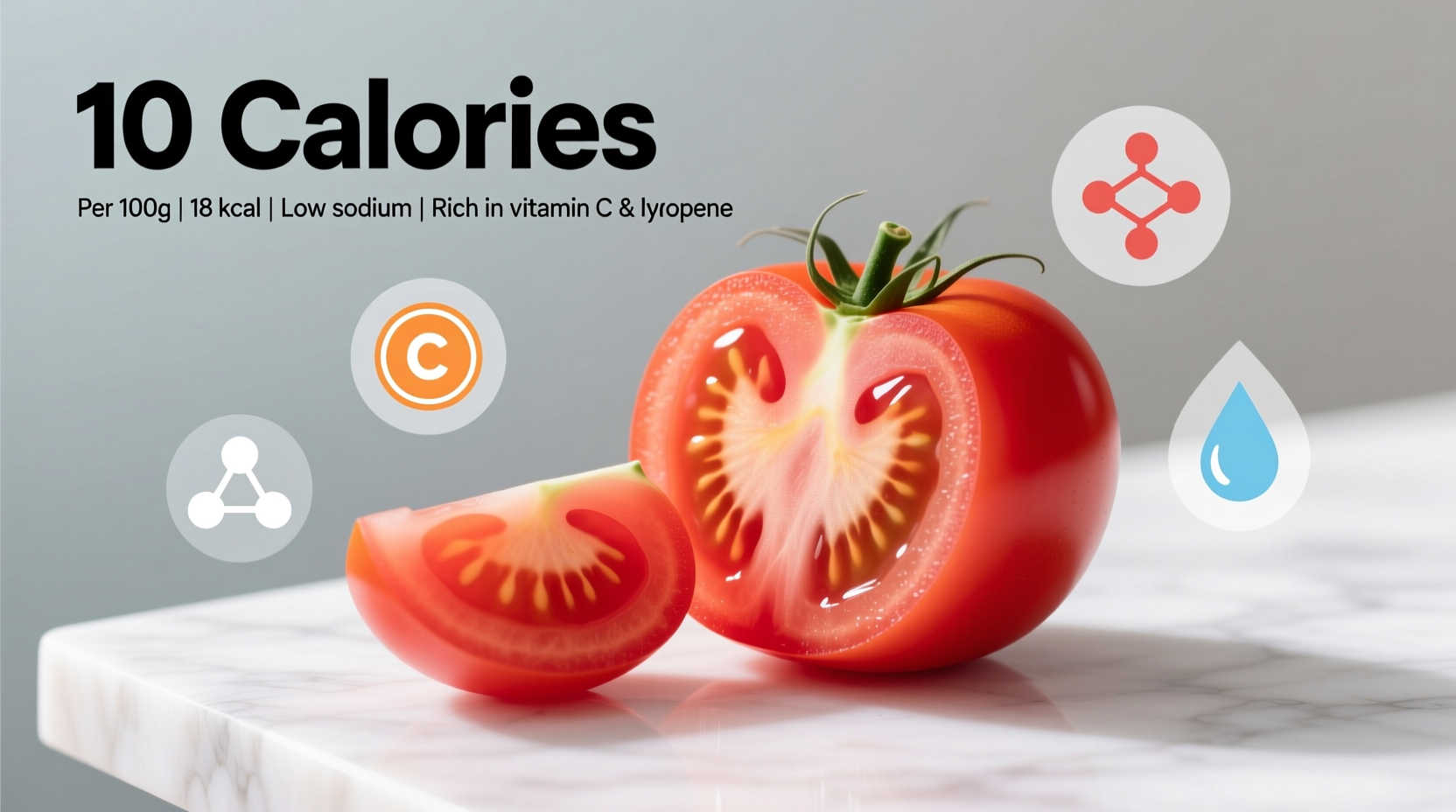When you're counting calories or building a balanced meal, knowing the exact nutritional value of common ingredients matters. Tomatoes rank among the most versatile and nutrient-rich vegetables (technically fruits!) in our kitchens. Let's explore the precise calorie content across different tomato varieties and sizes, so you can make informed choices for your dietary needs.
Understanding Tomato Sizes and Their Calorie Counts
"One tomato" isn't a standardized measurement - the calorie count varies significantly based on size and variety. The United States Department of Agriculture (USDA) provides precise nutritional data through their FoodData Central database, which serves as the gold standard for nutritional information in the United States.
| Tomato Type | Average Weight | Calories | Carbohydrates |
|---|---|---|---|
| Cherry tomato (1 piece) | 17g | 3 calories | 0.6g |
| Grape tomato (1 piece) | 10g | 2 calories | 0.4g |
| Roma/plum tomato (1 medium) | 62g | 11 calories | 2.4g |
| Medium round tomato | 123g | 22 calories | 4.8g |
| Large tomato | 182g | 33 calories | 7.1g |
| Beefsteak tomato (1 slice) | 60g | 11 calories | 2.4g |
This nutritional comparison shows how dramatically calorie counts change with tomato size. The data comes directly from USDA FoodData Central, ensuring you're working with scientifically verified information rather than estimates.
Calories in Tomatoes by Weight
For precise tracking, nutritionists recommend measuring by weight rather than count. According to USDA measurements:
- 100 grams of raw tomato contains 18 calories
- One cup of cherry tomatoes (about 149g) contains 27 calories
- One cup of diced tomatoes (about 180g) contains 32 calories
These measurements help when recipes specify "cups" rather than individual tomatoes. The slight variations between tomato varieties (like Roma vs beefsteak) are minimal enough that 18 calories per 100g serves as a reliable general rule for raw tomatoes.

Nutritional Benefits Beyond Calories
While the low calorie count makes tomatoes ideal for weight management, their nutritional profile offers much more value. A medium tomato provides:
- Nearly 28% of your daily vitamin C needs
- About 20% of your recommended vitamin K
- Significant potassium content (430mg per medium tomato)
- Lycopene, a powerful antioxidant with numerous health benefits
- Only 4.8 grams of carbohydrates, mostly from natural sugars
Research from the National Institutes of Health shows that lycopene absorption increases when tomatoes are cooked or processed, making tomato sauce and paste excellent sources of this antioxidant despite having slightly higher calorie density than raw tomatoes.
Practical Applications for Your Diet
Understanding how many calories in one tomato helps you make smarter choices in various eating scenarios:
For Weight Management
With just 22 calories for a medium tomato, they're perfect for adding volume to meals without significant calorie impact. Try:
- Replacing higher-calorie ingredients in sandwiches and burgers
- Adding to omelets for flavor without extra fat
- Creating low-calorie pasta sauces using blended tomatoes
For Meal Planning Accuracy
When tracking calories, be specific about which tomato variety you're using. Many calorie tracking apps default to "medium tomato" (22 calories), but if you're using cherry tomatoes, you'll need to adjust for the smaller size and higher sugar concentration.
Context Matters: When Tomato Calories Add Up
While plain tomatoes are extremely low-calorie, be mindful of preparation methods that increase calorie density:
- Tomato sauces with added sugar or oil
- Stuffed tomatoes with cheese or meat fillings
- Tomato-based soups with cream or butter
A simple marinara sauce might add only 70-80 calories per cup, while a creamy tomato soup can reach 200+ calories per serving. Always consider the complete dish when tracking calories in tomato-based recipes.
Tomato Nutrition Through History
Interestingly, modern tomatoes contain similar calorie counts to their historical counterparts, but their nutritional profile has evolved. According to research published in the Journal of Nutrition, selective breeding over the past century has slightly decreased lycopene content in some commercial varieties while increasing yield and shelf life. Heirloom varieties often contain higher concentrations of certain nutrients, though their calorie content remains virtually identical to conventional tomatoes.
Maximizing Tomato Nutrition in Your Kitchen
To get the most nutritional value from your tomatoes while keeping track of how many calories in one tomato:
- Store tomatoes at room temperature until ripe, then refrigerate
- Cook tomatoes with a small amount of healthy fat (like olive oil) to increase lycopene absorption
- Use the entire tomato, including the nutrient-rich gel surrounding the seeds
- Pair with vitamin C-rich foods to enhance iron absorption from plant sources
Whether you're following a Mediterranean diet, keto plan, or simply eating more whole foods, understanding the precise calorie content of tomatoes helps you make informed choices without sacrificing flavor or nutrition.











 浙公网安备
33010002000092号
浙公网安备
33010002000092号 浙B2-20120091-4
浙B2-20120091-4